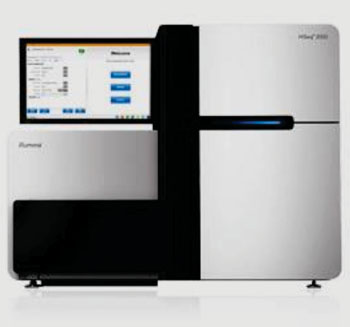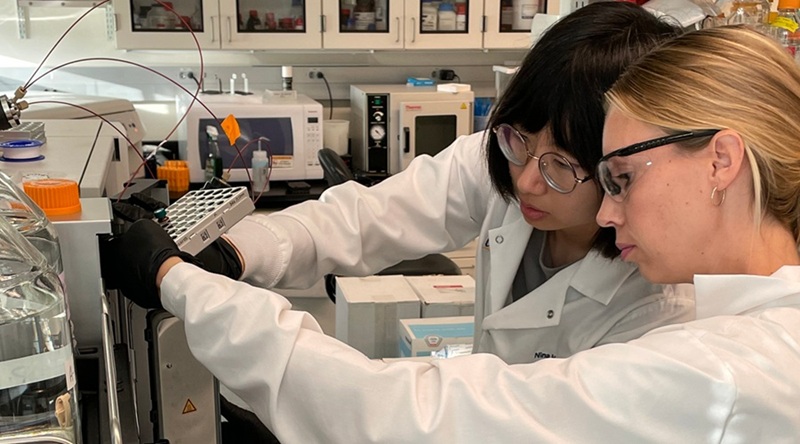New Virus Identified in Blood Supply
|
By LabMedica International staff writers Posted on 30 Sep 2015 |

Image: The HiSeq 2500 sequencing platform (Photo courtesy of Illumina).
Transfusion of blood or blood-derived products can save lives and improve health but requires safety measures for preventing bystander transmission of infectious agents.
To investigate the transmission of novel infectious agents by blood transfusion, changes in the virome composition of blood transfusion recipients pre- and post-transfusion has been studied.
An international group of scientists led by those at Columbia University (New York, NY, USA) collected serum samples from four participating blood centers distributed across the USA from July 1974 through June 1980. They performed high-throughput sequencing on blood samples from 46 individuals in the in the Transfusion-Transmitted Viruses Study (TTVS). They also performed high-throughput sequencing on samples from 106 individuals in the Multicenter Hemophilia Cohort Study who received plasma-derived clotting factor concentrates.
Total ribonucleic acid (RNA) extracts were reverse transcribed using a SuperScript III kit (Invitrogen Life Technologies; Carlsbad, CA, USA) with random hexamer primers. After processing, samples with low concentrations were amplified by increasing polymerase chain reaction (PCR) cycle numbers from 9 to 14. All sequencing was done on the Illumina HiSeq 2500 platform (Illumina; San Diego, CA, USA), yielding an average of 150 million reads per sequencing lane.
The team analyzed samples both pre- and post-transfusion and along with a variety of known viruses, they identified a new virus in two individuals. The virus was only present in post-transfusion samples, and additional tests showed that both patients were able to clear the virus. Genetic analysis determined that the novel human virus, human hepegivirus 1 (HHpgV-1) was related to Hepatitis C virus (HCV) and human Pegivirus (HPgV; formerly called GB virus C or Hepatitis G virus). Genomic testing of 70 additional individuals in the TTVS study failed to detect further cases of the virus detected. HHpgV-1 was found in serum samples from two blood transfusion recipients and two hemophilia patients who had received plasma-derived clotting factor concentrates.
Amit Kapoor, PhD, an assistant professor and lead author of the study said, “HHpgV-1 is unique because it shares genetic similarity with both highly pathogenic HCV and the apparently non-pathogenic HPgV. People need to be aware of this new infection in humans. We just don't know how many viruses are transmitted through the blood supply. There are so many viruses out there, and they need to be characterized in order to ensure that transfusions are safe.” The study was published on September 22, 2015, in the journal mBio.
Related Links:
Columbia University
Invitrogen Life Technologies
Illumina
To investigate the transmission of novel infectious agents by blood transfusion, changes in the virome composition of blood transfusion recipients pre- and post-transfusion has been studied.
An international group of scientists led by those at Columbia University (New York, NY, USA) collected serum samples from four participating blood centers distributed across the USA from July 1974 through June 1980. They performed high-throughput sequencing on blood samples from 46 individuals in the in the Transfusion-Transmitted Viruses Study (TTVS). They also performed high-throughput sequencing on samples from 106 individuals in the Multicenter Hemophilia Cohort Study who received plasma-derived clotting factor concentrates.
Total ribonucleic acid (RNA) extracts were reverse transcribed using a SuperScript III kit (Invitrogen Life Technologies; Carlsbad, CA, USA) with random hexamer primers. After processing, samples with low concentrations were amplified by increasing polymerase chain reaction (PCR) cycle numbers from 9 to 14. All sequencing was done on the Illumina HiSeq 2500 platform (Illumina; San Diego, CA, USA), yielding an average of 150 million reads per sequencing lane.
The team analyzed samples both pre- and post-transfusion and along with a variety of known viruses, they identified a new virus in two individuals. The virus was only present in post-transfusion samples, and additional tests showed that both patients were able to clear the virus. Genetic analysis determined that the novel human virus, human hepegivirus 1 (HHpgV-1) was related to Hepatitis C virus (HCV) and human Pegivirus (HPgV; formerly called GB virus C or Hepatitis G virus). Genomic testing of 70 additional individuals in the TTVS study failed to detect further cases of the virus detected. HHpgV-1 was found in serum samples from two blood transfusion recipients and two hemophilia patients who had received plasma-derived clotting factor concentrates.
Amit Kapoor, PhD, an assistant professor and lead author of the study said, “HHpgV-1 is unique because it shares genetic similarity with both highly pathogenic HCV and the apparently non-pathogenic HPgV. People need to be aware of this new infection in humans. We just don't know how many viruses are transmitted through the blood supply. There are so many viruses out there, and they need to be characterized in order to ensure that transfusions are safe.” The study was published on September 22, 2015, in the journal mBio.
Related Links:
Columbia University
Invitrogen Life Technologies
Illumina
Latest Molecular Diagnostics News
- New 15-Minute Hepatitis C Test Paves Way for Same-Day Treatment
- Ovarian Cancer Assay Outperforms Traditional Tests in Early Disease Detection
- Ultrasensitive Method Detects Low-Frequency Cancer Mutations
- Blood Test Enables Non-Invasive Endometriosis Detection
- New Blood Biomarkers Help Diagnose Pregnancy-Linked Liver Complication
- Simple Urine Test to Revolutionize Bladder Cancer Diagnosis and Treatment
- Blood Test to Enable Earlier and Simpler Detection of Liver Fibrosis
- Genetic Marker to Help Children with T-Cell Leukemia Avoid Unnecessary Chemotherapy
- Four-Gene Blood Test Rules Out Bacterial Lung Infection
- New PCR Test Improves Diagnostic Accuracy of Bacterial Vaginosis and Candida Vaginitis
- New Serum Marker-Editing Strategy to Improve Diagnosis of Neurological Diseases
- World’s First Genetic Type 1 Diabetes Risk Test Enables Early Detection
- Blood Test to Help Low-Risk Gastric Cancer Patients Avoid Unnecessary Surgery
- First-Of-Its-Kind Automated System Speeds Myeloma Diagnosis
- Blood Protein Profiles Predict Mortality Risk for Earlier Medical Intervention
- First Of Its Kind Blood Test Detects Gastric Cancer in Asymptomatic Patients
Channels
Clinical Chemistry
view channel
Online Tool Detects Drug Exposure Directly from Patient Samples
Doctors often rely on patient interviews and medical records to determine what medications a person has taken, but this information is frequently incomplete. People may forget drugs they used, take over-the-counter... Read more
Chemical Imaging Probe Could Track and Treat Prostate Cancer
Prostate cancer remains a leading cause of illness and death among men, with many patients eventually developing resistance to standard hormone-blocking therapies. These drugs often lose effectiveness... Read moreMolecular Diagnostics
view channel
New 15-Minute Hepatitis C Test Paves Way for Same-Day Treatment
Chronic hepatitis C infection affects an estimated 50 million people worldwide and causes around 242,000 deaths each year, largely due to cirrhosis and liver cancer. Although the infection is curable with... Read more
Ovarian Cancer Assay Outperforms Traditional Tests in Early Disease Detection
Globally, ovarian cancer is one of the deadliest cancers affecting women. Traditionally, early diagnosis of ovarian cancer has been challenging. Many ovarian cancers are diagnosed only after they have... Read moreHematology
view channel
MRD Tests Could Predict Survival in Leukemia Patients
Acute myeloid leukemia is an aggressive blood cancer that disrupts normal blood cell production and often relapses even after intensive treatment. Clinicians currently lack early, reliable markers to predict... Read more
Platelet Activity Blood Test in Middle Age Could Identify Early Alzheimer’s Risk
Early detection of Alzheimer’s disease remains one of the biggest unmet needs in neurology, particularly because the biological changes underlying the disorder begin decades before memory symptoms appear.... Read more
Microvesicles Measurement Could Detect Vascular Injury in Sickle Cell Disease Patients
Assessing disease severity in sickle cell disease (SCD) remains challenging, especially when trying to predict hemolysis, vascular injury, and risk of complications such as vaso-occlusive crises.... Read more
ADLM’s New Coagulation Testing Guidance to Improve Care for Patients on Blood Thinners
Direct oral anticoagulants (DOACs) are one of the most common types of blood thinners. Patients take them to prevent a host of complications that could arise from blood clotting, including stroke, deep... Read moreImmunology
view channel
Routine Blood Test Can Predict Who Benefits Most from CAR T-Cell Therapy
CAR T-cell therapy has transformed treatment for patients with relapsed or treatment-resistant non-Hodgkin lymphoma, but many patients eventually relapse despite an initial response. Clinicians currently... Read more
New Test Distinguishes Vaccine-Induced False Positives from Active HIV Infection
Since HIV was identified in 1983, more than 91 million people have contracted the virus, and over 44 million have died from related causes. Today, nearly 40 million individuals worldwide live with HIV-1,... Read more
Gene Signature Test Predicts Response to Key Breast Cancer Treatment
DK4/6 inhibitors paired with hormone therapy have become a cornerstone treatment for advanced HR+/HER2– breast cancer, slowing tumor growth by blocking key proteins that drive cell division.... Read more
Chip Captures Cancer Cells from Blood to Help Select Right Breast Cancer Treatment
Ductal carcinoma in situ (DCIS) accounts for about a quarter of all breast cancer cases and generally carries a good prognosis. This non-invasive form of the disease may or may not become life-threatening.... Read morePathology
view channel
Rapid Low-Cost Tests Can Prevent Child Deaths from Contaminated Medicinal Syrups
Medicinal syrups contaminated with toxic chemicals have caused the deaths of hundreds of children worldwide, exposing a critical gap in how these products are tested before reaching patients.... Read more
Tumor Signals in Saliva and Blood Enable Non-Invasive Monitoring of Head and Neck Cancer
Head and neck cancers are among the most aggressive malignancies worldwide, with nearly 900,000 new cases diagnosed each year. Monitoring these cancers for recurrence or relapse typically relies on tissue... Read more
Common Health Issues Can Influence New Blood Tests for Alzheimer’s Disease
Blood-based tests for Alzheimer’s disease are transforming diagnosis by offering a simpler alternative to spinal taps and brain imaging. However, many people evaluated at memory clinics also live with... Read more
Blood Test Formula Identifies Chronic Liver Disease Patients with Higher Cancer Risk
Chronic liver disease affects millions worldwide and can progress silently to hepatocellular carcinoma (HCC), one of the deadliest cancers globally. While surveillance guidelines exist for patients with... Read moreTechnology
view channel
Machine Learning Models Diagnose ALS Earlier Through Blood Biomarkers
Amyotrophic lateral sclerosis (ALS) is a rapidly progressive neurodegenerative disease that is notoriously difficult to diagnose in its early stages. Early symptoms often overlap with other neurological... Read more
Artificial Intelligence Model Could Accelerate Rare Disease Diagnosis
Identifying which genetic variants actually cause disease remains one of the biggest challenges in genomic medicine. Each person carries tens of thousands of DNA changes, yet only a few meaningfully alter... Read moreIndustry
view channel
Abbott Acquires Cancer-Screening Company Exact Sciences
Abbott (Abbott Park, IL, USA) has entered into a definitive agreement to acquire Exact Sciences (Madison, WI, USA), enabling it to enter and lead in fast-growing cancer diagnostics segments.... Read more



















